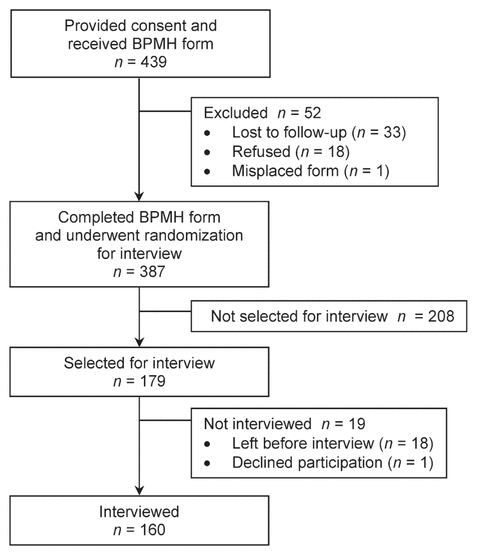
Figure 1 Flow chart depicting patient identification for interview. BPMH = best possible medication history.
Nicole MacDonald, Leslie Manuel, Haley Brennan, Erin Musgrave, Richard Wanbon, George StoicaABSTRACT
Background
Accreditation standards have outlined the need for staff in emergency departments to initiate the medication reconciliation process for patients who are at risk of adverse drug events. The authors hypothesized that a guided form could be used by non-admitted patients in the emergency department to assist with completion of a best possible medication history (BPMH).
Objective
To determine the percentage of patients in the non–acute care area of the emergency department who could complete a guided BPMH form with no clinically significant discrepancies (defined as no major discrepancies and no more than 1 moderate discrepancy).
Methods
This prospective exploratory study was conducted over 4 weeks in February and March 2016. Data were collected using the self-administered BPMH form, patient interviews, and a data collection form. After completion of the guided BPMH form, patients were randomly selected for interview by a pharmacy team member to ensure their self-completed BPMH forms were complete and accurate. Eligible patients were those with non-acute needs who had undergone triage to the waiting room. Patients who were already admitted and those with immediate triage to the acute care or trauma area of the emergency department were excluded.
Results
Of the 160 patients who were interviewed, 146 (91.3%) completed the form with no more than 1 moderate discrepancy (but some number of minor discrepancies). There were no discrepancies in 31 (19.4%) of the BPMH forms, and 101 (63.1%) of the forms had only minor discrepancies.
Conclusions
Most of the patients interviewed by the pharmacy team were able to complete the BPMH form with no clinically significant discrepancies. The self-administered BPMH form would be a useful tool to initiate medication reconciliation in the emergency department for this patient population, but used on its own, it would not be a reliable source of BPMH information, given the relatively low number of patients who completed the form with no discrepancies.
KEYWORDS: medication reconciliation, best possible medication history, emergency department, patient interview
RÉSUMÉ
Contexte
Les normes d’agrément ont souligné la nécessité pour le personnel des services des urgences d’amorcer le processus de bilan comparatif des médicaments chez les patients à risque d’événements indésirables liés aux médicaments. Les auteurs ont avancé que des patients au service des urgences ne requérant pas une hospitalisation pourraient remplir un formulaire dirigé et ainsi aider à établir leur meilleur schéma thérapeutique possible (MSTP).
Objectif
Déterminer le pourcentage de patients dans l’aire de soins non urgents du service des urgences qui sont en mesure de remplir un formulaire dirigé de MSTP sans divergence cliniquement significative (c’est-à-dire aucune divergence majeure et pas plus d’une divergence modérée).
Méthodes
La présente étude préliminaire prospective a été menée sur une période de quatre semaines en février et en mars 2016. Les données ont été recueillies à l’aide d’un formulaire autoadministré de MSTP, d’entrevue avec les patients et d’un formulaire de collecte de données. Une fois les formulaires dirigés de MSTP remplis, des patients ont été sélectionnés aléatoirement et interrogés par un des membres de l’équipe de pharmacie afin de s’assurer de l’exhaustivité et de l’exactitude des renseignements fournis de soi-même. Les patients admissibles à l’étude étaient ceux ne nécessitant pas de soins urgents et ayant passé au triage dans la salle d’attente. Les patients déjà hospitalisés et ceux dirigés immédiatement après le triage dans l’aire de soins urgents ou de trauma du service des urgences ont été exclus.
Résultats
Parmi les 160 patients interrogés, 146 (91,3 %) avaient rempli le formulaire avec au plus une divergence modérée (mais un certain nombre de divergences mineures). Dans 31 (19,4 %) des formulaires de MSTP, il n’y avait aucune divergence et, dans 101 (63,1 %) des formulaires, il n’y avait que des divergences mineures.
Conclusions
La plupart des patients interrogés par l’équipe de pharmacie étaient en mesure de remplir le formulaire de MSTP sans qu’apparaisse de divergence cliniquement significative. Le formulaire autoadministré de MSTP serait un outil pratique pour établir un bilan comparatif des médicaments dans le service des urgences pour cette population de patients, mais employé seul, il ne représenterait pas une source fiable d’information sur le MSTP, compte tenu du nombre relativement restreint de patients ayant rempli le formulaire sans qu’apparaisse de divergence.
KEYWORDS: bilan comparatif des médicaments, meilleur schéma thérapeutique possible, service des urgences, entrevue avec le patient
Accreditation Canada has introduced a new Required Organizational Practice outlining the need for staff in emergency departments to initiate the medication reconciliation process by generating a best possible medication history (BPMH) for a target group of patients without a decision to admit who are at risk for potential adverse drug events.1 Many of the patients with triage to the non–acute care area of the emergency department of The Moncton Hospital are not assessed by clinical pharmacy staff because of their low acuity. Medication records for these patients are obtained from the triage nurse, the patient’s own list, or the patient’s actual medications, as brought to the emergency department. However, studies have shown that the medication list in the triage record is often incomplete.2,3
The emergency department is a logical location for initiating BPMH practices, given that medication lists obtained in this setting are used to alter or initiate medication treatments for patients presenting to a hospital. In a recent survey of Canadian hospitals, 39% of respondents reported that pharmacy services were provided in the emergency department and that the emergency pharmacy teams prioritized patients who were to be admitted for obtaining a BPMH.4,5 Only 23% of respondents reported having adequate staff to comply with the new Required Organizational Practice.5 This finding implies that additional staff or improvements in current processes (or both) would be required to meet Accreditation Canada’s standards, which also require that medication reconciliation be performed for admitted patients.1 Up to 27% of all hospital prescribing errors can be attributed to medication histories being incomplete at the time of admission, with 27% to 83% of patients having at least 1 medication history error at the time of admission with the potential to adversely affect care over the long term.6–8
Accreditation Canada does not identify which patients would be considered at high risk and which would be most at risk for adverse drug events. Therefore, Canadian emergency departments must develop a risk assessment approach to identify these groups. Hohl and others9 have produced criteria for identifying patients at risk of adverse drug events, including adverse drug reactions. These criteria are intended to lead to an adverse drug event assessment by a clinical pharmacist, which presumably would include obtaining a BPMH.
The current health care literature has limited evidence concerning completion of a BPMH by patients. Previous studies (including published reports10–13 and unpublished data by one of the authors [R.W.]) have shown that a high percentage of patients are capable of independently completing some form of a medication history. To date, no published studies have examined the effectiveness of having non-admitted patients in the emergency department complete their own BPMH forms.
This study examined the effectiveness of a guided form to assist in completion of a BPMH by patients in the non-admitted population of the emergency department. It was hypothesized that having patients initiate their own BPMH might allow health care professionals to efficiently continue with the medication reconciliation process. The primary objective of this study was to determine the percentage of patients in the non-admitted area of the emergency department who could complete a guided BPMH form with no clinically significant discrepancies (defined as no major discrepancies and no more than 1 moderate discrepancy). The secondary objectives were to identify the proportion of patients who recorded responses to all of the questions on the guided form, the type and incidence of discrepancies observed between the self-completed form and information gathered by a pharmacy team member, patients’ perceptions about the request to complete a BPMH form before assessment, and the proportion of patients who met both the project’s high-risk criteria (as modified from Hohl and others9) and the primary outcome in the current study.
This prospective exploratory study involved patients who presented to the emergency department of The Moncton Hospital, a 380-bed acute care hospital in Moncton, New Brunswick. The study was reviewed and approved by the Horizon Health Network Research Ethics Board.
Those eligible for inclusion were non-acute patients not currently admitted, with the BPMH form being completed either by the patients themselves or by a caregiver on their behalf. Patients who had already been admitted and those with immediate triage to the acute care or trauma areas of the emergency department were excluded.
Data were collected by members of The Moncton Hospital pharmacy team (including N.M., L.M., and H.B.), consisting of both pharmacists and pharmacy assistants, all of whom had emergency department and medication reconciliation experience. A convenience sample was obtained over a 4-week period in February and March 2016, between the hours of 0730 and 1530, Monday to Friday.
The self-administered BPMH form was created after a review of other patient-directed forms, with questions included on the form targeting information known to be useful for completing a BPMH.10,11,14 The BPMH form and associated data collection tool (for use by pharmacy team members, as described below) were piloted at The Moncton Hospital on 3 separate occasions before formal data collection began, to ensure ease of use by both the patient and the pharmacy interviewer. Patients were invited to complete the BMPH form after registration, while waiting to be seen by a physician. The BPMH form (Appendix 1, available at https://www.cjhp-online.ca/index.php/cjhp/issue/view/122/showToc) and accompanying consent form were offered in both English and French. Once consent was obtained, the patient’s name was added to a project identifier sheet, with numbering according to order of registration in the emergency department.
An online random number generator (Research Randomizer, https://www.randomizer.org) was used to identify patients who would be interviewed by a pharmacy team member, according to their numbers on the project identifier sheet; a 1:1 ratio was planned for patients who would and would not be interviewed. Patients identified for an interview were approached by a pharmacy team member and then interviewed in accordance with the standard medication reconciliation procedure of the Canadian Patient Safety Institute,15 used at The Moncton Hospital. The pharmacy team member used a minimum of 2 sources to verify the patient-completed BPMH form, including the patients themselves, medication vials, medication lists, and the community pharmacy. A data collection tool was developed to ensure a consistent approach in identifying discrepancies and collecting data from both paper and electronic records (Appendix 2, available at https://www.cjhp-online.ca/index.php/cjhp/issue/view/122/showToc). After the interview, patients were asked several questions regarding their satisfaction with the process of completing the BPMH form.
The principal investigator (N.M.) organized all of the project data using the data collection tool. This included recording demographic data, as well as the reason for the visit, any interventions in the emergency department, the discharge diagnosis, and the discrepancies identified by the pharmacy team member during the patient interview. All of the patients’ medications were classified by the principal investigator according to the AHFS Clinical Drug Information classification system of the American Society of Health-System Pharmacists,16 and the number of high-alert medications, as defined by the Institute for Safe Medication Practices,17 was recorded. An external panel with emergency medicine experience (consisting of 1 physician, 1 nurse, and 1 pharmacist) examined the discrepancies identified for each interviewed patient and categorized them on the basis of both type and severity. To ensure a consistent approach, the panel used standardized definitions for minor, moderate, and major discrepancies. These definitions, which were based on several studies,18–22 are provided in Appendix 3 (available at https://www.cjhponline.ca/index.php/cjhp/issue/view/122/showToc), which also defines the 4 categories of discrepancy used in the study. Differences of opinion among panel members were discussed and resolved by consensus.
After the interviews and data collection were completed, patients considered to be at risk for adverse drug events were identified from among the interviewed patients using criteria modified from those of Hohl and others9 (i.e., 1 or more classes of a medication or antibiotic used within the past 7 days plus age > 80 years or a medication start or stop within the past month).
Descriptive statistics were used to quantify various markers of interest, including discrepancies (number, severity, and classifications), answers to survey questions (numeric results and Likert scale scores), and classes of medications. Univariate logistic regression was performed to predict both number and type of discrepancies according to age, sex, number of medications, and relevant classes of medications. Further analysis was required to identify differences among the discrepancies; hence, multinomial logistic regression was used to compare major + moderate discrepancies versus minor discrepancies.
A total of 439 patients provided consent, of whom 52 were excluded for various reasons and 387 completed some or all of the BPMH form (Figure 1). These 387 patients underwent randomization, and 179 were selected for an interview. Of these 179 patients, 1 patient declined to take part in the interview because of illness, and 18 patients left the emergency department or were discharged before the interview could take place. The remaining 160 patients were interviewed, and their characteristics are presented in Table 1.
|
|
||
|
Figure 1 Flow chart depicting patient identification for interview. BPMH = best possible medication history. |
||
Table 1 Patient Characteristics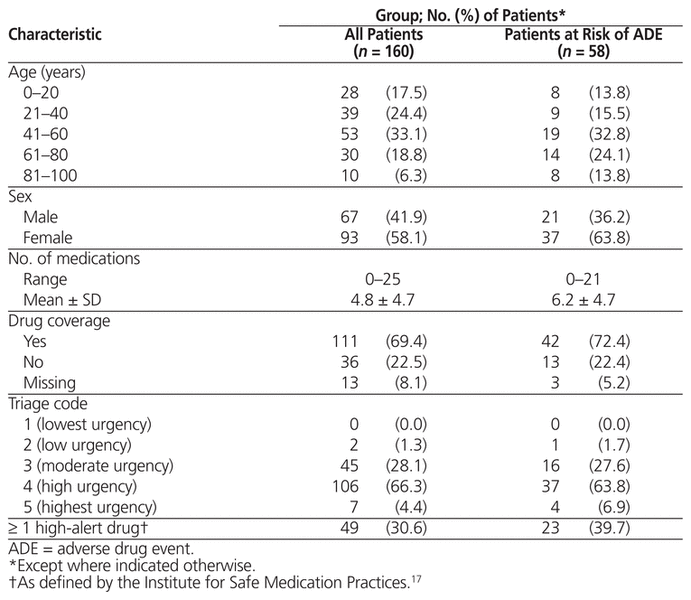
A total of 154 (39.8%) of the 387 patients completed all questions on the BPMH form, with 35 patients (9.0%) leaving more than half of the questions incomplete. The majority of questions had high completion rates, including 382 (98.7%) patients completing the request for a list of all prescription and nonprescription medications. In addition, more than 97% of the patients completed the questions that involved circling yes/no options. The questions about whether patients had started or stopped any medications within the past month had lower completion rates: 245 (63.3%) and 225 (58.1%), respectively. These questions were located on the back of the double-sided BPMH form. After removal of these 2 questions from the analysis, the total number of patients who completed the rest of the form was 241 (62.3%). On incomplete BPMH forms, the questions on page 2 were most often the questions left unanswered.
For the primary objective, 146 (91.3%) of the 160 interviewed patients completed the form with no more than 1 moderate discrepancy, plus some number of minor discrepancies. In this group, 31 of the patients (19.4% of all those interviewed) had no discrepancies on their BPMH forms, 101 (63.1%) had only minor discrepancies, and 14 (8.8%) had 1 moderate discrepancy (Table 2). Although the number of patients who completed the form with no discrepancies was low, the panel found that the majority of discrepancies were minor in severity, with minimal clinical significance.
Table 2 Severity of Discrepancies for Patients Interviewed and Those at Risk of Adverse Drug Events (ADEs)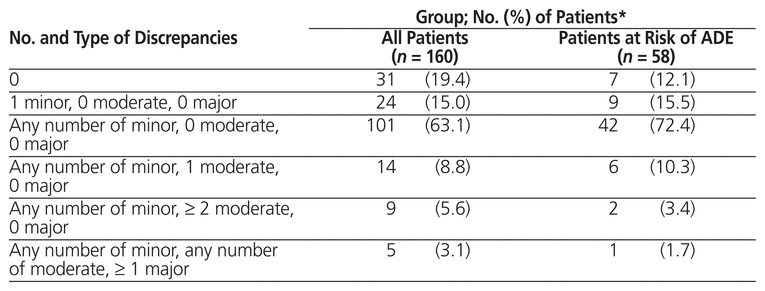
A total of 551 discrepancies were detected (median 2.5 per patient, interquartile range [IQR] 1–4). Most (503 [91.3%]) of these discrepancies were minor (median 2 per patient, IQR 1–4), some (41 [7.4%]) were moderate, and a few (7 [1.3%]) were major. The number of moderate + major discrepancies was not significantly different from the number of minor discrepancies (χ2 test). Of the 551 discrepancies, 190 (34.5%) were due to omissions and 176 (31.9%) were due to commissions (both with median 0 per patient, IQR 0–2); 92 (16.7%) were due to errors in patient’s reporting of dose, frequency, or route; and 93 (16.9%) were other types of discrepancies. Each of the 2 latter categories was not significantly different from the combined total number of discrepancies due to omissions and commissions. Table 3 shows discrepancy examples for each severity ranking.
Table 3 Examples of Discrepancies for Each Severity Ranking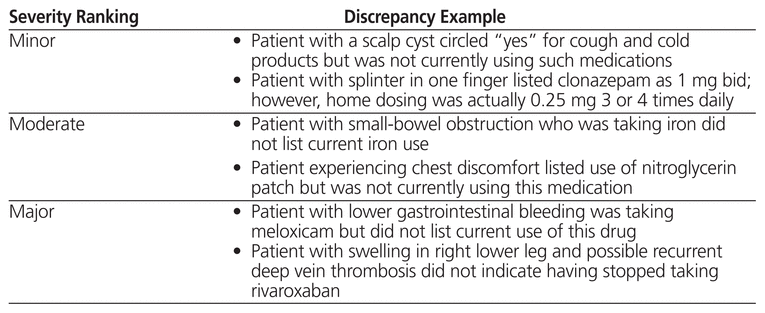
The patient satisfaction survey used a Likert scale of 1 (least favourable) to 7 (most favourable). All of the patients reported having enough time to complete the BPMH form while in the emergency department. A majority (154 [96.3%] of the 160 patients) felt comfortable with the health care team asking them to complete the form, and 156 (97.5%) felt comfortable with the type of questions on the BPMH form. A smaller number (135 [84.4%]) felt that the information they had provided on the form would be useful to their health care team (Table 4).
Table 4 Results of Patient Satisfaction Survey for BPMH Form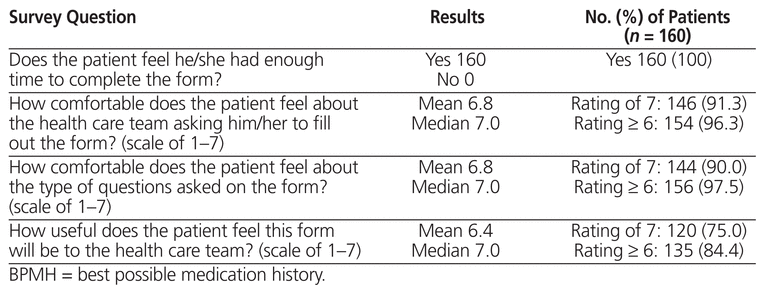
Of the 160 interviewed patients, 58 (36.3%) were classified as being at risk for adverse drug events, according to the modified criteria. Of this at-risk population, 55 patients (94.8%) completed the form with no more than 1 moderate discrepancy (plus any number of minor discrepancies). Seven (12.1%) of the patients had no discrepancies, 42 (72.4%) had only minor discrepancies, and 6 (10.3%) had 1 moderate discrepancy (Table 2).
In both the overall group of patients interviewed (n = 160) and the subgroup of at-risk patients (n = 58), the most common medication class was central nervous system (CNS) medications (99 [61.9%] and 43 [74.1%], respectively). The next 2 most common medication classes were vitamins (51 [31.9%] and 25 [43.1%], respectively) and cardiovascular drugs (49 [30.6%] and 24 [41.4%], respectively).
In the overall group of 160 interviewed patients, there were no significant differences in the incidence of discrepancies among the 26 AHFS classes of medication. In the at-risk population, however, certain patients were more likely to have clinically relevant discrepancies, specifically patients taking a Class 9 (CNS) medication (odds ratio [OR] 3.70, 95% confidence interval [CI] 1.85–20.18; p = 0.007) and those with an increased number of medications (OR 2.92, 95% CI 1.41–18.30; p = 0.013). Most numerous among the AHFS classes with nonsignificant differences for the at-risk population were Class 7 (cardiovascular) drugs, followed by Class 25 agents (vitamins). According to a univariate Wald logistic regression, the 2 independent variables, CNS medication use and number of medications, were significant factors in predicting the occurrence of the dependent-variable discrepancies. Although the χ2 test results for age versus discrepancies and sex versus discrepancies were significant, once the other variables were controlled for, there was not a strong relationship between age or sex versus discrepancies (p > 0.05). In this at-risk population, the OR values indicated that older males were the most likely category of patients to have a larger number of discrepancies with increases in either the number of overall medications or the number of CNS medications.
Logistic regression was used to look for possible relationships between discrepancy severity and the 2 significant independent variables identified with the univariate regression analysis for the at-risk population. The designated reference group was minor discrepancies because, by default, the statistical software package (SPSS Statistical Package, IBM, Armonk, New York) sorted the groups and selected the most frequent category as the reference. There was a significant difference in number between moderate and minor discrepancies, but not between major and minor discrepancies, when the 2 independent variables (CNS medications and older age) were controlled for. For at-risk patients, when the number of medications increased, minor discrepancies were more likely to occur than moderate discrepancies (OR 0.96, 95% CI 0.96–0.99; p = 0.031), and when the number of CNS medications increased, moderate discrepancies were more likely to occur than minor discrepancies (OR 2.26, 95% CI 1.05–4.86, p = 0.028).
The overall group of patients interviewed and the at-risk patients appeared to perform similarly with regard to the primary objective (completion of the BPMH form with no clinically significant discrepancies) and in terms of the other results pertaining to the specific discrepancies identified. Given that most of the forms completed by patients were not error-free, further consultation between the patient and a member of the health care team would still be required to ensure the patient-completed forms represent the BPMH.
During this study of a new approach to obtaining the BPMH, the emergency department team had access to a more complete medication history than is traditionally obtained at triage. Additional information in the medication history can improve both the quality and the efficiency of care provided by the emergency department team. Here, the BPMH form provided valuable information about patients who would typically not be seen by a pharmacy team member. Although time for medication reconciliation was not objectively measured, pharmacy team members reported that the BPMH form helped to decrease the time required to complete a patient’s medication reconciliation. The BPMH form gave team members a starting list and key background information, including the patient’s regular community pharmacy, additional medical insurance coverage, allergies, and recent antibiotic use. Having access to the information on the BPMH form allowed for streamlining of care.
The patient survey indicated high levels of satisfaction with the BPMH form. Most patients indicated a high level of comfort with the form and its perceived value to the health care team. Only patients who consented to participate in the study were surveyed, which may have resulted in selection bias.
This study had a number of limitations. It may have been subject to additional selection bias because the number of patients who initially refused to complete the BPMH form could not be determined. The study was conducted with a convenience sample on weekdays (Monday to Friday) from 0730 to 1530; therefore, it is unclear whether the results would be applicable to patients coming to the emergency department on other days or at other times or to patients seen in other settings. The definitions for severity and type of discrepancy have not been validated in an outpatient population.18–22 Several questions on the BPMH form had relatively low response rates, which may indicate a need for further clarification within the form. A possible improvement might be to add a yes/no selection option for questions about recently starting or stopping medications, and for the question inquiring about tobacco, alcohol, and recreational drug use. The questions on the second page of the BPMH form had lower completion rates, which indicates that the form may have been too long to hold the attention of some patients. Health care professionals with emergency department experience, such as the panel members who categorized the type and severity of medication discrepancies, may assign lower severity ratings (relative to health care professionals without emergency experience), because they are used to making decisions on the basis of limited information; this may have represented an additional source of bias. Another potential limitation is that the discrepancy panel interpreted “yes” responses for medications that were not currently being used as “commission” discrepancies, which may have elevated the count of commission discrepancies above what would have been obtained otherwise. Finally, the severity of each discrepancy was assessed separately, not in combination with all identified discrepancies for that patient. Multiple minor discrepancies in the same patient could increase the potential for a more severe adverse event than what the panel selected.
The criteria used to identify the at-risk patient population were modified from the criteria of Hohl and others9 for identifying adverse drug events. Because of the convenience sample size, only CNS medications, number of overall medications, and age appeared to increase the number and severity of discrepancies. A multicentre study might have sufficient power to detect additional factors.
In this study, the investigators were unable to assess all of the statistics initially planned, because the sample size was not large enough to power certain analyses. These included examining possible correlations between patient-specific factors and the severity or type of discrepancies, as well as better defining the patient population that could complete the form with a higher or lower number of discrepancies.
Several factors may have contributed to the strength of this study. A randomization process was used to identify patients for interview, and the interview was standardized. The use of an external panel representing various disciplines (all with experience in the emergency department) provided valuable and consistent ranking of discrepancy severity and classification of discrepancy type according to their front-line clinical experience. As well, for most analyses, less than 5% of data were missing. This research provides important contextual information for emergency departments (especially those with limited resources) that are trying to comply with the new Accreditation Canada Required Organizational Practice for obtaining a BPMH for patients without a decision to admit. The BPMH form used in this study may have potential for expansion to other health care areas where patients are required to wait before being seen by the health care team. Having patients become more active participants in their own care is a common goal of health care teams.
In this study, most of the patients who were interviewed by the pharmacy team were able to complete the self-administered BPMH form with no clinically significant discrepancies and had high satisfaction rates regarding their perception of the form. Consequently, care of non-admitted patients in the emergency department may be improved by using this form to obtain patients’ medication histories. However, the number of patients who were able to complete the form with no discrepancies at all was low (31 patients or 19.4% of the interviewed group). Therefore, the completed BPMH form could be used to initiate the medication reconciliation process in the emergency department, but a follow-up patient interview would be required to identify and resolve any discrepancies. As such, the self-administered BPMH form would be a useful tool but is not reliable on its own as the definitive BPMH. This study provides a foundation for future research in this area, which could examine possible implementation of the self-administered BPMH form in other care areas and with other patient populations.
1 Required organizational practices handbook 2015. Ottawa (ON): Accreditation Canada; 2015 [cited 2015 Oct 25]. Available from: www.accreditation.ca/sites/default/files/rop-handbook-2015-en.pdf. [Payment required to access content.]
2 Mazer M, DeRoos F, Hollander JE, McCusker C, Peacock N, Perrone J. Medication history taking in emergency department triage is inaccurate and incomplete. Acad Emerg Med. 2011;18(1):102–4.

3 Shepherd G, Schwartz RB. Frequency of incomplete medication histories obtained at triage. Am J Health Syst Pharm. 2009;66(1):65–9.
4 Wanbon R, Lyder C, Villeneuve E, Shalansky S, Manuel L, Harding M. Clinical pharmacy services in Canadian emergency departments: a national survey. Can J Hosp Pharm. 2015;68(3):191–201.

5 Wanbon R, Lyder C, Villeneuve E, Shalansky S, Manuel L, Harding M. Medication reconciliation practices in Canadian emergency departments: a national survey. Can J Hosp Pharm. 2015;68(3):202–9.

6 Dobrzanski S, Hammond I, Khan G, Holdsworth H. The nature of hospital prescribing errors. Br J Clin Gov. 2002;7(3):187–93.
7 Tam VC, Knowles SR, Cornish PL, Fine N, Marchesano R, Etchells EE. Frequency, type and clinical importance of medication history errors at admission to hospital: a systematic review. CMAJ. 2005;173(5):510–5.


8 Nilsson N, Lea M, Lao Y, Wendelbo K, Gløersen G, Mowé M, et al. Medication discrepancies revealed by medication reconciliation and their potential short-term and long-term effects: a Norwegian multicentre study carried out on internal medicine wards. Eur J Hosp Pharm. 2015;22(5):298–303.
9 Hohl CM, Yu E, Hunte GS, Brubacher JR, Hosseini F, Argent CP, et al. Clinical decision rules to improve the detection of adverse drug events in emergency department patients. Acad Emerg Med. 2012;19(6):640–9.

10 Witting MD, Hayes BD, Schenkel SM, Drucker CB, DeWane MP, Lantry JH 3rd, et al. Emergency department medication history taking: current inefficiency and potential for a self-administered form. J Emerg Med. 2013; 45(1):105–10.

11 Boissonnault WG, Badke MB. Collecting health history information: the accuracy of a patient self-administered questionnaire in an orthopedic outpatient setting. J Am Phys Ther Assoc. 2005;85(6):531–43.
12 Nasr I, Cordero M, Houmes B, Fagan J, Rydman R, Grenn C. Use of a bilingual medical history questionnaire in the emergency department. Ann Emerg Med. 1993;22(5):824–8.

13 Hershey CO, Grant BJB. Controlled trial of a patient-completed history questionnaire: effects on quality of documentation and patient and physician satisfaction. Am J Med Qual. 2002;17(4):126–35.

14 Meyer C, Stern M, Woolley W, Jeanmonod R, Jeanmonod D. How reliable are patient-completed medication reconciliation forms compared with pharmacy lists? Am J Emerg Med. 2011;30(7):1048–54.

15 Medication reconciliation in acute care: getting started kit. Version 3. Edmonton (AB): Canadian Patient Safety Institute; 2011 [cited 25 Oct 2015]. Available from: https://tools.patientsafetyinstitute.ca/Communities/MedRec/Shared%20Documents/Calls/Medrec_AC_English_GSK_V3-1.pdf
16 McEvoy GK, editor. 2015. AHFS drug information [database]. 56th ed. Bethesda (MD): American Society of Health-System Pharmacists; 2015 [cited 2015 Oct 1]. Accessed through STAT!Ref online electronic medical library, available from: http://online.statref.com/Document.aspx?fxId=1&docId=1 [subscription required to access content].
17 ISMP high-alert medications. Horsham (PA): Institute for Safe Medication Practices; 2015 [cited 25 Oct 2015]. Available from: https://www.ismp.org/tools/highalertmedicationLists.asp
18 Cornish PL, Knowles SR, Marchesano R, Tam V, Shadowitz S, Juurlink DN, et al. Unintended medication discrepancies at the time of hospital admission. Arch Intern Med. 2005;165(4):424–9.

19 Kumar S, Dahal P, Venkataraman R, Fuloria PC. Assessment of clinical pharmacist intervention in tertiary care teaching hospital of Southern India. Asian J Pharm Clin Res. 2013;6 Suppl 2:258–61.
20 Blix HS. Drug-related problems in hospitalised patients: a prospective bedside study of an issue needing particular attention [PhD dissertation]. Oslo (Norway): University of Oslo; 2007.
21 A risk matrix for risk managers. London (UK): National Patient Safety Agency; 2008 [cited 2015 Oct 25]. Available from: www.npsa.nhs.uk/nrls/improvingpatientsafety/patient-safety-tools-and-guidance/riskassessment-guides/risk-matrix-for-risk-managers/
22 Price M, Bowen M, Lau F, Kitson N, Bardal S. Assessing accuracy of an electronic provincial medication repository. BMC Med Inform Decis Mak. 2012;12(42):1–7.
Competing interests: None declared. ( Return to Text )
Funding: None received. ( Return to Text )
Acknowledgements: The authors would like to thank Denise LeBlanc-Duchin, BSc, MA, PhD, for statistical support and data analysis, as well as Pam Walsh, MD, Glenn Myers, BScPharm, ACPR, and Anne Saulnier, BScN, for their contributions as discrepancy panel judges. The authors would also like to thank pharmacy team members Cathy Leblanc, BScPharm, Meaghan Hayes, PHA, and Katie Friars, PHA.
Canadian Journal of Hospital Pharmacy, VOLUME 70, NUMBER 4, July-August 2017